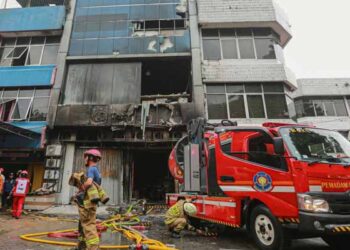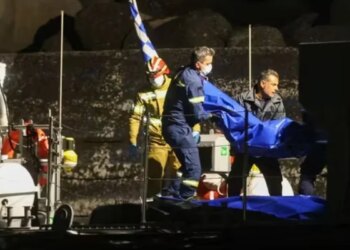Select Language:
Earthquake in Myanmar Causes Widespread Damage and Casualties
Image caption: A general view of a collapsed building in the aftermath of a powerful earthquake in Mandalay, Myanmar, March 30, 2025. — Reuters
- 3,400 Injured, 300 Missing Following Earthquake
- Rescue Teams From India, China, Singapore, and Thailand Mobilized
- UN Agency Reports Hospitals Struggling in Hard-Hit Regions
BANGKOK: The death toll from Myanmar’s recent earthquake has been steadily increasing, prompting foreign rescue teams and aid to flood into the impoverished nation. The disaster has overwhelmed hospitals, and affected communities are hastily trying to orchestrate rescue operations with limited resources.
The 7.7-magnitude earthquake struck the war-torn Southeast Asian country on Friday, marking one of the most powerful quakes in Myanmar in a century. By Sunday, official reports indicated approximately 1,700 casualties, 3,400 injuries, and over 300 people unaccounted for.
The military government’s leader, Senior General Min Aung Hlaing, acknowledged the devastating impact and indicated that the death toll might rise. This admission came three days after he publicly requested international assistance, according to state media.
Neighboring countries, including India, China, and Thailand, have sent relief supplies and teams, with additional support coming from Malaysia, Singapore, and even Russia.

Image caption: A vehicle trapped beneath the debris of a collapsed building in Mandalay, Myanmar, March 30, 2025. — Reuters
"The devastation is severe, and humanitarian needs are escalating rapidly," said a statement from the International Federation of Red Cross and Red Crescent Societies. They emphasized the urgent requirement to stabilize affected communities, especially as temperatures rise and the monsoon season approaches.
The United States has committed $2 million in aid through local humanitarian organizations and has dispatched an emergency response team from USAID, which has been experiencing budget cuts under the Trump administration.
This catastrophe further compounds the suffering in Myanmar, already grappling with a civil conflict following a military coup in 2021 that ousted the democratically elected government led by Nobel laureate Aung San Suu Kyi.

Image caption: Search and rescue operations ongoing in Mandalay, Myanmar, March 29, 2025. — Reuters
Critical infrastructure—including bridges, highways, airports, and railways—has been damaged across the country, hampering humanitarian operations amid ongoing conflict that has displaced over 3.5 million individuals and severely weakened the health system.
In some areas near the epicenter, residents reported a lack of government assistance, forcing them to fend for themselves. “Restoring transportation routes swiftly is essential,” Min Aung Hlaing instructed officials, as state media reported on efforts to repair railway lines and reopen airports to make rescue efforts more effective.
According to predictive models from the U.S. Geological Survey, the death toll in Myanmar could eventually exceed 10,000, with economic losses surpassing the nation’s annual GDP.
‘No Assistance, No Rescuers’

Image caption: Rescuers working at a collapsed building site in Mandalay, Myanmar, March 30, 2025. — Reuters
Hospitals in central and northwestern Myanmar, including the city of Mandalay and the capital Naypyidaw, are struggling to accommodate the influx of injured individuals, as reported by the UN Office for the Coordination of Humanitarian Affairs.
The earthquake’s tremors also impacted parts of Thailand, where an under-construction skyscraper collapsed, resulting in 18 fatalities, according to reports from Thai authorities. Recovery efforts continued for the third day, with 76 individuals trapped under the debris.
The opposition National Unity Government of Myanmar, which comprises remnants of the previous administration, declared a two-week halt to offensive military actions starting Sunday.
In regions like Sagaing, near the earthquake’s epicenter, the extent of destruction is significant. “We are witnessing widespread devastation—counts of buildings reduced to rubble,” resident Han Zin reported. He noted that much of the town has been without power and is running short on drinking water. “We have not received any aid, and there are no rescue personnel present.”
Sections of a major bridge connecting Sagaing with Mandalay have collapsed, with satellite images revealing parts of the historical structure submerged in the Irrawaddy River. “With the bridge out, even aid from Mandalay is hardly making its way here,” stated the Sagaing Federal Unit Hluttaw, associated with the NUG, on social media.

Image caption: Rescuers transporting a deceased victim in Mandalay, Myanmar, March 30, 2025. — Reuters
“Food and medical supplies are scarce, and the number of casualties is overwhelming our local hospital, which is not equipped to handle the influx of patients.”
‘Can You Hear Me?’
Mandalay’s extensive damage has left many people trapped beneath collapsed buildings, with heavy machinery required for rescue operations that are currently out of reach, according to humanitarian workers stationed in the area.
"Our teams are utilizing gloves, ropes, and basic tools to dig for survivors," one worker said, on the condition of anonymity due to security concerns. “Countless people are still trapped and we cannot ascertain the death toll at this time because we don’t know who is alive or who is lost.”
A video taken by a local Mandalay resident revealed patients lying outside a 500-bed orthopedic hospital where no space was available.
Public and private healthcare facilities in Mandalay, including the Mandalay General Hospital and sections of Mandalay Medical University, suffered damage from the quake, the World Health Organization reported.
Rescue personnel from Russia and India are en route to Mandalay, with multiple teams from China, Thailand, and Singapore already on-site.
In Bangkok, rescuers have been tirelessly working at the site of the demolished 33-story building, surrounded by piles of concrete and twisted metal, in hopes of rescuing workers sealed beneath the wreckage.
Teerasak Thongmo, a Thai police commander, mentioned that his team is racing against time to locate any survivors. “Our immediate goal is to find those who might still be alive. We have a crucial 72-hour window to act,” he noted.
Nearby, relatives of the missing and trapped construction workers gathered, anxiously awaiting news. Some were visibly distressed. “Ploy, Ploy, I’m here for you!” cried one woman, overwhelmed with emotion. “Ploy, can you hear me?”







